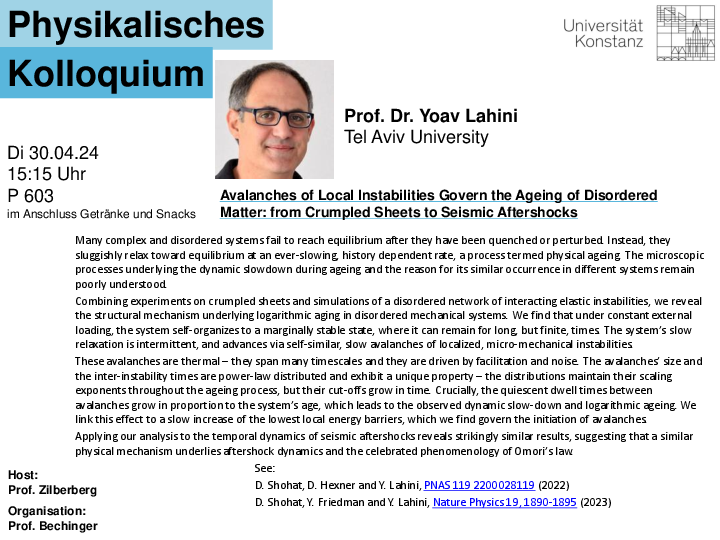Physikalisches Kolloquium: Avalanches of Local Instabilities Govern the Ageing of Disordered Matter: from Crumpled Sheets to Seismic Aftershocks
Wann
Dienstag, 30. April 2024
15:15 bis 16:45 Uhr
Wo
P 603 im Anschluss Getränke und Snacks
Veranstaltet von
Gastgeber: Prof. Zilberberg / Organisation: Prof. Bechinger
Vortragende Person/Vortragende Personen:
Prof. Dr. Yoav Lahini Tel Aviv University
Many complex and disordered systems fail to reach equilibrium after they have been
quenched or perturbed. Instead, they sluggishly relax toward equilibrium at an ever-slowing,
history dependent rate, a process termed physical ageing. The microscopic processes
underlying the dynamic slowdown during ageing and the reason for its similar occurrence in
different systems remain poorly understood.
Combining experiments on crumpled sheets and simulations of a disordered network of
interacting elastic instabilities, we reveal the structural mechanism underlying logarithmic
aging in disordered mechanical systems. We find that under constant external loading, the
system self-organizes to a marginally stable state, where it can remain for long, but finite,
times. The system’s slow relaxation is intermittent, and advances via self-similar, slow
avalanches of localized, micro-mechanical instabilities.
These avalanches are thermal –they span many timescales and they are driven by facilitation
and noise. The avalanches’ size and the inter-instability times are power-law distributed and
exhibit a unique property –the distributions maintain their scaling exponents throughout the
ageing process, but their cut-offs grow in time. Crucially, the quiescent dwell times between
avalanches grow in proportion to the system’s age, which leads to the observed dynamic
slow-down and logarithmic ageing. We link this effect to a slow increase of the lowest local
energy barriers, which we find govern the initiation of avalanches.
Applying our analysis to the temporal dynamics of seismic aftershocks reveals strikingly
similar results, suggesting that a similar physical mechanism underlies aftershock dynamics
and the celebrated phenomenology of Omori’s law.

